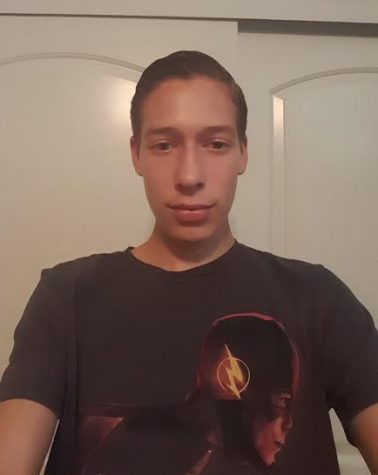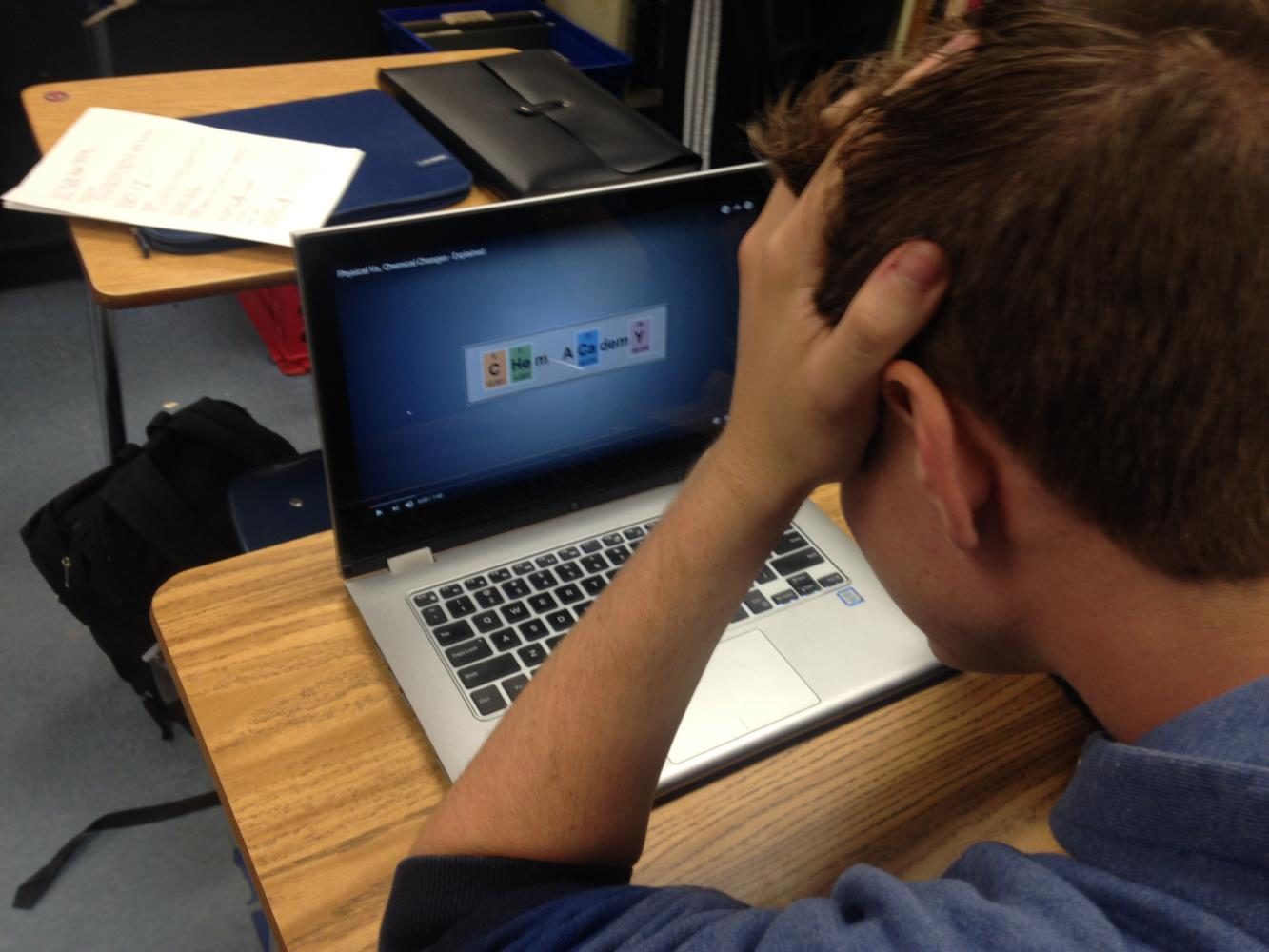Online Chemistry: The Flawed Format
Picture by Cody Wilson
Casey Swafford frets over online chemistry
EDIT: This article originally generalized a lack of ChromeBooks to the entire chemistry program, but while Mr. Glancy’s classes lacked them at the time this was published, Millings had a dedicated set of ChromeBooks. Further, students last year were suggested to subscribe to Millings’s channel instead of being forced, as the article implies.
Chemistry is a staple of the traditional high school curriculum. Every bad high school movie has at least one scene of chemicals exploding in teenagers’ faces. Yet, the chemistry program at Quartz Hill High School has very few labs involving dangerous chemicals – or physical labs at all.
For more than five years, the majority of the chemistry program has been operating with an online format. Using the Moodle platform, Mr. Glancy and Mr. Millings are the two main teachers for online chemistry. Students usually have assignments with randomized, computer-generated questions to do each day, and they learn the content through videos created by Mr. Millings. In fact, every student is suggested to subscribe to Millings’s YouTube channel, ChemAcademy. Both teachers supplement these videos with lectures in class.
Instead of doing physical labs like traditional chemistry courses, Glancy has transitioned to online labs. As an alternative to handling chemicals and beakers, students click flasks on their screens and conduct experiments using a mouse. Lauro Vargas, an Honors Chemistry student, appreciated the ability to do “online labs you couldn’t do during school.” He acknowledged these artificial experiments are not as exciting as traditional labs, but students still “understand what it means.”
There are many advantages to chemistry’s new medium. Students receive instant feedback on whether they are doing problems correctly, and the program often tells them what they are doing wrong. With this function of the online format, students know immediately if their answers are correct, and they are graded on accuracy, not completion.
Further, the lessons are easily accessible to students with internet access at home. Every video is online, and the assignments are open whether a student is in class or not. Glancy explained, “When I started doing this in `99, I literally had a chalkboard and chalk, and if you weren’t in class for whatever reason, you didn’t get the notes and you had to get them from somebody else.” Now, absent students can easily learn what they missed and keep up-to-date in the course.
However, students with access to technology or the internet at home are not able to experience the online chemistry course. To ensure that students do not have this problem, Mr. Glancy asks the students without the required technological assets to tell him ahead of time. He explained, “I try and catch that at the beginning, and get people to tell me that so that way I can find them the proper place to be.”
The only chemistry course available on campus that is not based online is taught by Dr. Smoot. She still prefers to teach chemistry the traditional way. In contrast to Glancy and Millings, Smoot is strict with technology in her class, and she usually prohibits phone use.
While it seems logical that disadvantaged students should be switched into Smoot’s class, she only teaches regular Chemistry. Students that want the extra challenge or GPA bump of Honors Chemistry must have Internet access. Smoot’s course is usually slower and covers less material than the Honors classes.
However, an advantage to regular Chemistry is the material is thoroughly-covered and less rushed than online chemistry. Glancy explained, “From the end of quarter three, we see we have all these units to do and there’s no way to get through all of them.” However, Smoot does not feel obligated to cover every unit Honors Chemistry does, preferring quality over quantity.
Nevertheless, the student who is unable to take the online course loses out on an honors course due to both the lack of assets at home and a lack of assets at school.
Quartz Hill does not provide adequate resources for the chemistry program. The largest problem is the lack of a dedicated ChromeBook carts for the students taking the online course. However, ChromeBooks often face difficulties even when they are available. The online labs do not work on these devices, and Glancy must compete for access to one of the campus computer labs with other teachers. The chemistry program is looking into other possibilities such as a supply of Kindle Fire tablets, but there is likely not enough funding yet for this to be possible.
Often, the students rely on mobile devices of their own rather than have a dedicated device to perform their work. However, mobile devices can be a hinderance, and Glancy highlighted this point: “[Phones are] distracting because you sit there and there’s 25 messages from Twitter and Instagram that are coming in your phone while you’re actually trying to concentrate on doing some chemistry.” Further, students must cope with annoying formatting changes that confuse their problems.
Due to phone and ChromeBook problems, some students often resort to doing the work at home. During class, students lacking technology sometimes goof around with friends. Sophomore Lauro Vargas said, “[The class is] pretty fun, actually, because it’s not really much work, so I mostly just play around in there with Thomas. We were playing Spoons today.”
Often, those who do not complete work in class will become lazy and search for ways to cheat. The less-than-honorable students resort to paying others to complete their assignments. As a disadvantage, Glancy conceded, “You can pay somebody – ‘here’s my password, I’m going to pay you to do all the questions for me.’”
The teachers of the online format, however, have taken steps to decrease the persistent problem of cheating. During an examination, students must take their test in a pop-up tab, so they must close the window to search the internet. Unfortunately, this method to reduce cheating is not foolproof. Glancy admits, “If somebody is fast, they can close and re-open it before I can do anything.” He further explained, “If somebody’s motivated enough, they will always find a way to be dishonest with it.”
To combat this difficulty, the chemistry teachers who utilize the online format randomize the questions and the numbers. Students must know the process in order to complete a problem, rather than just ask a peer for an answer on an exam. On homework, while students get similar problem types, the numbers themselves are completely different. They can help each other with the process for completing the homework, but each student must complete their individual problems.
However, the cheating persists, and students confirm their classmates have an easy time lying about tests. Thomas Ortega, a current Honors Chemistry student, confirmed it is “easy to cheat” in the class. Lauro Vargas described, “I know a lot of people cheat with it because we usually just do it on our phones.”
The ideal way for the chemistry teachers to reduce cheating is to have an operating system that links the teacher’s computer to all of the students’ computers. Therefore, the teachers would be able to see what the students are doing. Such surveillance would be beneficial, as the teachers would have the capacity to effectively stop students from cheating. With this, Glancy described, “I can click to freeze somebody’s screen. So, if they are off on some other tab, I can freeze them there.” Unfortunately, ChromeBooks cannot handle this setup due to their lack of proper wiring.
Further, Glancy and Millings face the difficulty of creating questions that students cannot simply find on Google. “There are still things you can use an online calculator for […] like molar mass,” Glancy explained. “ In order to combat that, we’ve had to go to compounds that aren’t real or doing average atomic mass with an element that’s fictitious because you could just look up what the average atomic mass is.” So, in reducing the amount of cheating, another problem arises for the chemistry teachers. They must create fictitious elements, which may not be applicable to chemistry labs and may not provide accurate understanding of the course material.
Despite the teachers’ efforts with the online format, many students report a superficial understanding of the content covered in their chemistry course. Lauro Vargas explained, “I don’t feel like I really learned much. It felt like […] I was teaching myself pretty much because I just had to watch the videos to learn it.” While the content of the course is available online, students often require more interaction with teachers. The online format allows the students to complete all of the homework without much of a hassle, but the students do not truly understand the content provided in the course.
However, students have the capacity to be successful despite some of the issues that plague online chemistry. Thomas Ortega described, “It’s up to the person who’s doing it. If they really want to learn, they’ll learn. If you don’t want to learn, you won’t learn.” Hence, it is the responsibility of the student taking the chemistry course, online or traditional, to achieve success and ensure a proper understanding of the chemistry curriculum. While the teaching method and the format of the course is integral to understanding, it is ultimately up to the student to thrive with the provided content.
While the online format for chemistry is a good idea, the teachers do not have the infrastructure to make the program work as desired. First and foremost, the program needs an increased amount of funding and support, especially for dedicated devices to complete classwork and homework. Further, there are still flaws and inconsistencies afflicting the online format that need to be worked out. Online chemistry is a good idea in concept, but it still has many kinks that must be fixed for the concept to be executed to its fullest potential.

Hello! My name is Cody Wilson, and I am the fearless Editor-in-Chief of the Ubiquity! Although I originally joined journalism to draw pictures and write...

Cole Walls is the humor editor for the QHHS Ubiquity. However, he is actually from Central City and is known as the ‘Fastest Man Alive’ by many. While...








